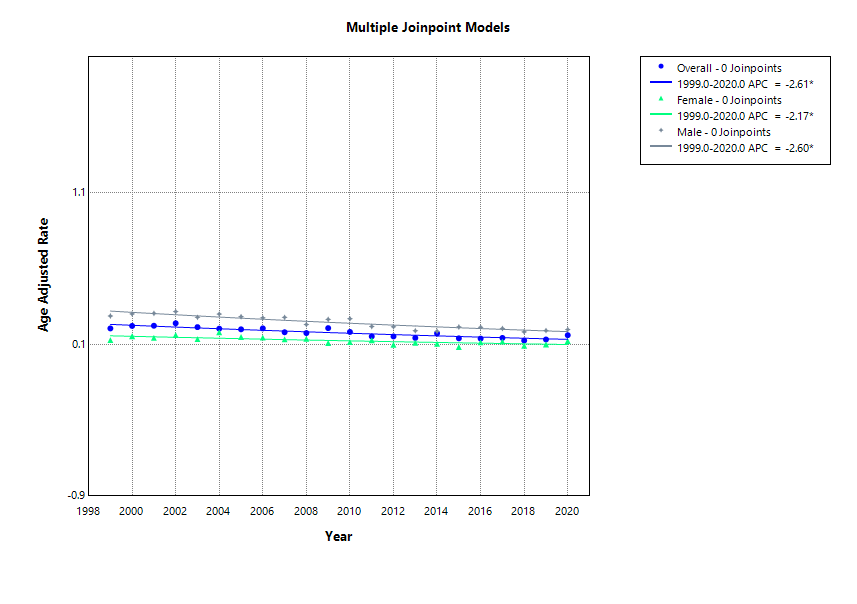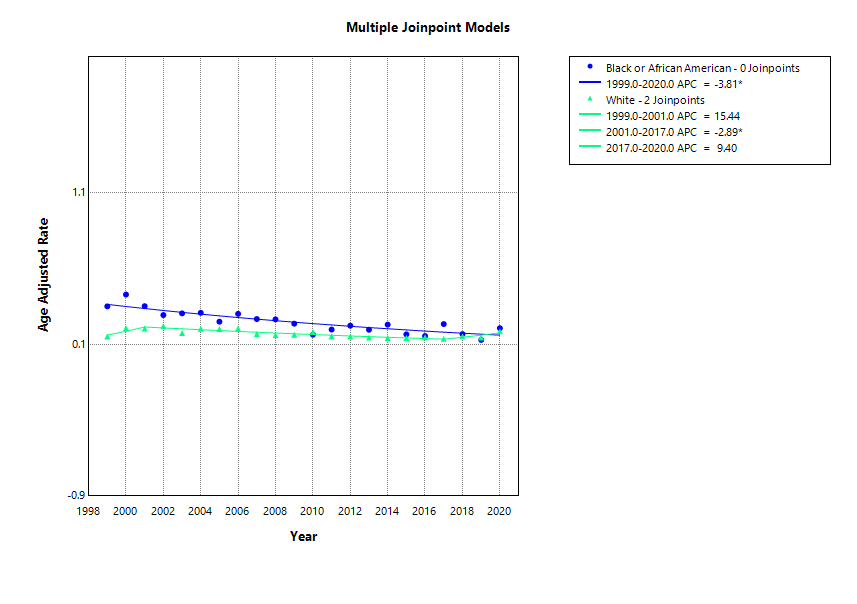Tuesday Poster Session
Category: Colon
P4599 - Trends and Disparities in Appendicitis Mortality in the United States Between 1999-2020

Shamitha Hejmadi, MD
Detroit Medical Center Sinai Grace Hospital
Detroit, MI
Presenting Author(s)
1St Francis Medical Center, Monroe, LA, Mumbai, Maharashtra, India; 2Detroit Medical Center Sinai Grace Hospital, Detroit, MI; 3Al-Tibri Medical College, Karachi, Sindh, Pakistan; 4Guntur Medical College, India, Guntur, Andhra Pradesh, India; 5Case Western Reserve University / MetroHealth, Cleveland, OH
Introduction:
Appendicitis is a significant cause of morbidity and mortality in the United States. The aim of this study is to determine the trends and disparities in appendicitis mortality in American adults older than 25 years between 1999-2020.
Methods:
Retrospective analysis of the CDC Wide-Ranging Online Data for Epidemiologic Research database was conducted. Deaths attributed to appendicitis were identified using ICD-10 codes K35-K37. Age-adjusted mortality rates (AAMRs) and crude death rates (CDRs) per 100,000 persons were calculated. Joinpoint regression was used to determine average annual percentage change (AAPC). Mortality trends were analyzed by sex, race, geography, and age group.
Results:
A total of 8,453 deaths were reported. The overall AAMR was 0.17, with a significant decline from 0.21 in 1999 to 0.16 in 2020 (AAPC:-2.61;p< 0.001). Males had a higher AAMR (0.24) than females (0.13) and experienced a greater decline in mortality (AAPC:-2.60 vs. -2.19;p< 0.001 for both). Among races, non-Hispanic(NH) American Indians/Alaskan Natives had the highest AAMR(0.28), followed by NH Black/African Americans(0.25), NH Whites(0.16), Hispanics/Latinos(0.14), and NH Asians(0.11). AAMRs declined across most racial groups, with the steepest decline among NH Blacks(AAPC:-3.81; p< 0.001), while NH Whites showed a slight, albeit non-significant increase(AAPC:0.42; p=0.77). Geographically, AAMR was highest in West(0.21), followed by Midwest(0.17), with the most notable regional decline observed in Midwest(AAPC:-3.05;p< 0.001). Nonmetropolitan areas had a higher AAMR(0.21) than metropolitan areas(0.17); however, metropolitan areas saw a greater decline(AAPC:-2.86 vs.-1.55;p< 0.001 and p=0.016, respectively). Among age groups, CDR was highest in those aged 85 years and older (1.7). While all age groups showed declining trends, the greatest reductions were observed in the 45-54 years(AAPC:-3.10;p< 0.001) and 65-74 years(AAPC:-3.08;p< 0.001) age groups.
Discussion:
Appendicitis mortality in the U.S. significantly declined between 1999-2020; however, disparities remain. Males, NH American Indians, residents of West, and nonmetropolitan populations experienced disproportionately higher mortality rates. Notably, while all other demographic groups saw a decline in AAMR, NH Whites saw an increase, although not significant. These findings identify critical areas for public health interventions to mitigate mortality risks.
Figure: Trends in appendicitis mortality (overall and for each sex) from 1999-2020.
Figure: Trends in appendicitis mortality for each racial group from 1999-2020.
Disclosures:
Dhruv Gandhi indicated no relevant financial relationships.
Shamitha Hejmadi indicated no relevant financial relationships.
Ayesha Cheema indicated no relevant financial relationships.
Wajdan Ahmad indicated no relevant financial relationships.
Samiksha Jain indicated no relevant financial relationships.
Rishi Chowdhary indicated no relevant financial relationships.
Dhruv Gandhi, MD1, Shamitha Hejmadi, MD2, Ayesha Cheema, MBBS3, Wajdan Ahmad, MBBS3, Samiksha Jain, MBBS4, Rishi Chowdhary, MD5. P4599 - Trends and Disparities in Appendicitis Mortality in the United States Between 1999-2020, ACG 2025 Annual Scientific Meeting Abstracts. Phoenix, AZ: American College of Gastroenterology.
